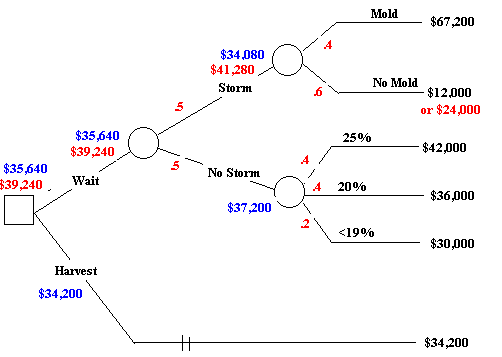- At the outset, there are two alternatives: (1) wait (W)
for the storm to hit, if it will; (2) Harvest (H) now. If
waited, the storm may or may not hit. If it hits, the mold may or may
not form, greatly affecting the revenue. If the storm hits and no mold
forms, the eventual sugar level, which determines the quality of the
wine and hence the revenue, is uncertain. Likewise the
uncertainty about the mold is quite important as it determines
the difference between an exquisite wine versus a thin wine that the
winery may be unwilling to risk their reputation by selling it under
company label. This calls for another decision (if storm hits and
the mold does not form): whether to sell the grapes in bulk (B)
or make the thin wine and sell it under label (T). This decision
however is different in that, the EV criterion will always favor making
the wine since EV maximizes the current returns but cannot consider the
long term marketing impact of selling the thin wine now. Thus this
decision must be made outside the framework of the sequential decision
based on monetary EV.

The blue values are based on the
assumption of selling thin wine in bulk, while the red numbers assume the thin wine will be bottles
and sold for $2.00/bottle.
According to the above decision tree, solved on the assumption of (B),
waiting for the storm has an EV of $35,640 versus (H) with an
inferior EV of $34,200. Admittedly the difference is rather small
(about 4.2% higher). If (T) is used the EV of (W) goes up
to $39,240 which is substantially more. However one has to consider the
negative long term strategic effects of (T).
- If the probability of the mold is only 20%
a) On the assumption that the
thin wine will be 